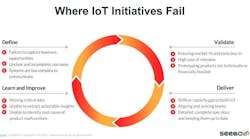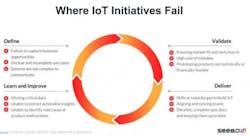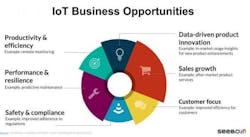Submitted by Seebo
The IIoT offers manufacturers a range of business benefits from improving product performance, quality, and safety, to leading data-driven development, and increasing customer satisfaction. And yet, only 26 percent of IIoT initiatives are succeeding; these benefits outside the reach of most companies.
Based on research from dozens of companies, these are the top reasons why IIoT projects fail or stall in each phase of product development, and how to avoid them.
Phase 1: Definition
The first stage of IIoT planning, in which teams generate and define their product concepts and use cases, sets the course of development.
Here we see three recurring issues:
Failure to capture business opportunities
Companies are focused on the product they want to deliver without having clearly defined, and roadmapped their business objectives.
These objectives can range from sales growth to improved product resilience and efficiency. Without these considerations driving development, teams are launching connected products that don’t deliver their promised benefits.
Unclear or incomplete use cases
In addition to defining product concepts and business objectives, understanding and fully communicating your IIoT use cases–whether it’s predictive maintenance, remote asset monitoring, etc.– is central to the success of an IIoT initiative.
Systems are too complex to communicate
An IIoT system involves many units (a device, cloud, gateway, app, and data integration, to name a few) and several new development partners (for app development to analytics, security and more).
In order to take an IIoT initiative beyond the concept phase, teams must define their system’s logic and requirements with a bullet-proof spec, facilitate centralized collaboration, and communicate the concept to stakeholders for making feedback-based iterations.
Phase 2: Validation
Companies that have advanced with IIoT initiatives beyond concept definition are faced with challenges of ensuring feasibility, market-fit, and early buy-in.
The result is that companies are investing resources in prototyping products that are not technically or financially viable, or they don’t have the backing of stakeholders and customers for laying the groundwork of a successful launch.
Adding to this is the fact that mistakes made in the validation phase of development cost on average ten times more than in definition, and these costs continue to multiply for product delivery and in-market. It’s clear that verifying the IIoT concept early on is key to containing project costs.
Fool-proofing specifications to detect mistakes made in hardware design, firmware or software logic, system architecture, and data integration, is paramount in connected product development. Working with a digital IoT simulator to simulate the connected product–from the physical device to dashboards–is an emerging approach to concept validation.
NASA, “The Cost Escalation Through the Project Lifecycle”
Phase 3: Delivery
New challenges arise as companies enter the development and testing phase of their IIoT initiatives. A staggering one out of three companies report lacking the complete skills required for IIoT–including data integration, web and mobile development, and security.
Not only do companies need to find external partners to supplement existing teams, but they also need to align and sync them throughout the development process. Here companies are faced with several challenges, among them maintaining complete and detailed specs which are kept up-to-date as changes occur.
Phase 4: In-Market
For IIoT products that launch to market, challenges remain for attaining success. Our research shows that the leading pains for companies are related to data collection and analysis.
In this phase, companies report missing critical data or finding it difficult to extract insights from available data in order to improve products, understand customers better, and make data-driven decisions.
Teams also struggle to leverage their product’s data to quickly identify malfunctions and get to the root cause of issues.
In order to overcome these obstacles, companies are turning to IIoT development platforms with tools designed for successful IIoT planning and delivery, from concept definition to in-market analytics.
Jackie Retig







